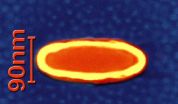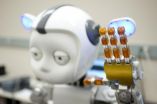(Press-News.org) Forget technology. The best prescription for patients with venous leg ulcers is good quality nursing care – and the occasional belly laugh!
A five-year study led from the University of Leeds has shown that ultrasound therapy does nothing to speed up the healing process of leg ulceration – contrary to what had been expected. Traditional methods of nursing care, which are cheaper and easier to deliver, work just as well, the authors conclude.
"The 'healing energy' of low-dose ultrasound can make a difference to some medical conditions but with venous leg ulcers, this is simply not the case," said Professor Andrea Nelson from the University of Leeds' School of Healthcare, who led the study.
"The key to care with this group of patients is to stimulate blood flow back up the legs to the heart. The best way to do that is with compression bandages and support stockings – not 'magic wands' - coupled with advice on diet and exercise. Believe it or not, having a really hearty chuckle can help too. This is because laughing gets the diaphragm moving and this plays a vital part in moving blood around the body."
Venous leg ulcers are common in people with varicose veins or mobility problems whose 'muscle pumps' in the feet and calves struggle to drive blood up to the heart. These ulcers can be painful and unsightly, having a significant negative impact on health and quality of life.
Although most leg ulcers will clear up with good nursing care, a significant proportion of the lesions will take 12 months or longer to heal. The older and larger ulcers become the harder they are to get rid of, hence the search for solutions that could speed-up the healing process.
A number of small studies had suggested that ultrasound could be the answer. Professor Nelson (University of Leeds), working with colleagues from the Universities of York and Teeside, and many NHS Trusts, have now shown that this is not the case.
The researchers concentrated on 'hard to heal' ulcers that had not cleared up after six months or longer. Drawing on patients from across the UK and Ireland, they found that adding ultrasound to the standard approach to care - dressings and compression therapy - made no difference to the speed of healing or the chance of the ulcers coming back. Ultrasound also raised the cost of care per patient by almost £200.
"Rising levels of obesity mean that the number of people who suffer from legs ulcers is likely to grow," Professor Nelson said. "We do need to find ways to helping those patients who ulcers won't go away, but our study shows that ultrasound is not the way to do that. We need to focus on what really matters, which is good quality nursing care. There really is no need for the NHS to provide district nurses with ultrasound machines. This would not be money well spent."
###
The study was funded by the National Institute for Health Research (NIHR) Health Technology Assessment Programme (HTA).
Full details of the findings are published online today in advance of publication in the British Medical Journal and Health Technology Assessment.
Notes to editors
1. The paper: 'Use of weekly, low dose high frequency ultrasound for hard to heal venous leg ulcers: the VenUS III randomised control trial', is available online in advance of publication in the British Medical Journal (BMJ 2011;342:d1092).
2. The report: 'VenUS III: a randomised controlled trial of therapeutic ultrasound in the management of venous leg ulcers' is available online in advance of publication in Health Technology Assessment (DOI: 10.3310/hta15130; see www.hta.ac.uk/1451).
3. One of the UK's largest medical, health and bioscience research bases, the University of Leeds delivers world leading research in medical engineering, cancer, cardiovascular studies, epidemiology, molecular genetics, musculoskeletal medicine, dentistry, psychology and applied health. Treatments and initiatives developed in Leeds are transforming the lives of people worldwide with conditions such as diabetes, HIV, tuberculosis and malaria. www.leeds.ac.uk
4. The National Institute for Health Research Health Technology Assessment (NIHR HTA) programme commissions research about the effectiveness, costs, and broader impact of health technologies for those who use, manage and provide care in the NHS. It is the largest NIHR programme and publishes the results of its research in the Health Technology Assessment journal, with over 550 issues published to date. The journal's 2008 Impact Factor (6.91) ranked it in the top 10% of medical and health-related journals. All issues are available for download free of charge from the website, www.hta.ac.uk.
5. The National Institute for Health Research provides the framework through which the research staff and research infrastructure of the NHS in England is positioned, maintained and managed as a national research facility. The NIHR provides the NHS with the support and infrastructure it needs to conduct first-class research funded by the Government and its partners alongside high-quality patient care, education and training. Its aim is to support outstanding individuals (both leaders and collaborators), working in world class facilities (both NHS and university), conducting leading edge research focused on the needs of patients. www.nihr.ac.uk
Laughter really is the best medicine (for leg ulcers)
2011-03-09
ELSE PRESS RELEASES FROM THIS DATE:
Roundworm could provide new treatment for sepsis
2011-03-09
Research by the University of Liverpool has found that systemic inflammation caused by sepsis can be suppressed by a protein which occurs naturally in a type of roundworm.
Sepsis is a serious inflammatory condition, caused by the body over-reacting to infection. The body becomes overwhelmed by bacteria, setting off a series of reactions that lead to inflammation and clotting. It affects around 20 million people worldwide each year, and accounts for a large proportion of intensive care unit admissions.
For the past 30 years, sepsis has largely been treated by antibiotics ...
Big games, close scores lead to more auto fatalities for winning fans
2011-03-09
Closely contested major sporting events are followed by a significant increase in traffic fatalities for fans of the winning team, according to new research from North Carolina State University. It turns out there may be more on the line than many sports fans bargained for.
"A previous study showed that traffic fatalities increased in the hours following the Super Bowl. We wanted to see if that held true for other high-profile sporting events and, if so, whether the number of fatalities was influenced by whether the game was a close one," says Dr. Stacy Wood, Langdon ...
Rituximab combined with a TNF inhibitor and methotrexate shows no safety signal in RA treatment
2011-03-09
A recent trial of rituximab in combination with a tumor necrosis factor (TNF) inhibitor and methotrexate (MTX) in patients with active rheumatoid arthritis (RA) found the safety profile to be consistent with other RA trials with TNF inhibitors. While the trial reported no new safety risks, clear evidence of an efficacy advantage in RA patients receiving the combination therapy was not observed in this study sample. Results of the trial are published in the March issue of Arthritis & Rheumatism, a peer-reviewed journal of the American College of Rheumatology.
The National ...
Sildenafil reduces Raynaud's frequency in patients with systemic sclerosis
2011-03-09
Researchers in Europe reported that treatment with modified-release sildenafil significantly reduced the frequency of attacks of Raynaud's phenomenon in patients with limited cutaneous systemic sclerosis (lcSSc), also known as scleroderma. The double-blind, placebo-controlled trial found that sildenafil was well tolerated with only some subjects experiencing minor or moderate side effects. Full findings are available in the March issue of Arthritis & Rheumatism, a journal published by Wiley-Blackwell on behalf of the American College of Rheumatology (ACR).
Raynaud's ...
Scanning antiquity underfoot
2011-03-09
According to rough estimates, there are some 20,000 undiscovered archaeological sites in Israel waiting to be explored. Currently buried under highways or beneath cities, some could reveal historic monuments from the biblical past and give us clues to the expansion and settlement of modern man as he made his way through the Fertile Crescent.
But where to begin? Who decides which sites should be "dug" — at considerable financial cost — and which should remain unexplored until a later date? A new tool from Prof. Lev Eppelbaum of Tel Aviv University's Department of Geophysics ...
New bowel cancer evidence calls for routine DNA repair test
2011-03-09
Bowel cancer patients whose tumors contain defects in specific DNA repair systems are much less likely to experience tumour recurrence post surgery, results from a major clinical study have demonstrated.
Scientists who collaborated on the 10 year QUASAR randomised control trial, one of the largest UK clinical trials to test the benefits of chemotherapy in post-surgery bowel cancer patients, have confirmed that colon tumors containing defects in their DNA mismatch repair system are 50 percent less likely to recur following surgery compared to tumors where DNA mismatch ...
Malaria's weakest link
2011-03-09
A group of researchers from EPFL's Global Health Institute (GHI) and Inserm (Institut National de la Santé et de la Recherche Médicale, the French government agency for biomedical research) has discovered that a class of chemotherapy drugs originally designed to inhibit key signaling pathways in cancer cells also kills the parasite that causes malaria. The discovery could quickly open up a whole new strategy for combating this deadly disease.
The research, published online in the journal Cellular Microbiology, shows that the malaria parasite depends upon a signaling pathway ...
Study: Homeless patients cost $2,500 more than the average patient for each hospital stay
2011-03-09
TORONTO, ON., March 8, 2011—Homeless patients cost about $2,500 more per hospital stay than the average patient, according to a new study by researchers at St. Michael's Hospital.
Homeless people with medical or surgical problems arrive at the hospital with underlying health issues and stay longer than others, often because there is no place to send them after their initial medical crisis has been treated, the study found. Those with psychiatric illness arrive at the hospital much sicker than others.
The findings suggest the cost of hospitalizing people who are homeless ...
Extremely fast MRAM data storage within reach
2011-03-09
This release is available in German.
Magnetic Random Access Memories (MRAM) are the most important new modules on the market of computer storage devices. Like the well known USB-sticks, they store information into static memory, but MRAM offer short access times and unlimited writing properties. Commercial MRAMs have been on the market since 2005. They are, however, still slower than the competitors they have among the volatile storage media. An invention made by the Physikalisch-Technische Bundesanstalt (PTB) changes this situation: A special chip connection, in association ...
How can robots get our attention?
2011-03-09
Getting someone's attention can be easy with a loud noise or a shout, but what if the situation calls for a little more tact? How can a robot use subtle cues to attract a human's notice and tell when it has captured it? In a preliminary study, researchers at the Georgia Institute of Technology have found that they can program a robot to understand when it gains a human's attention and when it falls short. The research is being presented today at the Human-Robot Interaction conference in Lausanne, Switzerland.
"The primary focus was trying to give Simon, our robot, the ...

